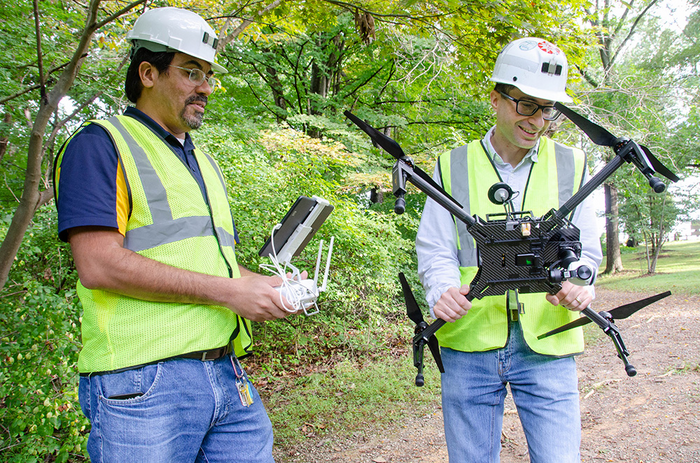Two West Virginia University engineers are developing new technologies for coal waste storage facilities that will detect and prevent potential failures like leakage of hazardous materials into the environment.

Credit: WVU Photo/Paige Nesbit
Two West Virginia University engineers are developing new technologies for coal waste storage facilities that will detect and prevent potential failures like leakage of hazardous materials into the environment.
Guilherme Pereira, associate professor in the mechanical and aerospace engineering department and adjunct associate professor in the Lane Department of Computer Science and Electrical Engineering, and Ihsan Berk Tulu, Wayne and Kathy Richards Faculty Fellow and assistant professor of mining engineering, received nearly $500,000 in funding to conduct research that will deliver an aerial robot-enabled inspection and monitoring system for active and abandoned coal ash and tailings or waste storage facilities.
The goal of the project is to find a way to detect leakages and failures at coal waste facilities before tailings and coal ash are released into the environment. Tailings are waste materials left behind after extracting coal from the earth that are stored above-ground behind earthen dams, whereas coal ash is a residue left over from burning coal at power plants. Coal ash is one of the largest U.S. supplies of industrial waste, containing metals such as lead, mercury, chromium, selenium, cadmium and arsenic, that never biodegrade and are dangerous to humans.
“Failure of these structures has been shown to be catastrophic, causing massive mudslides that have devastated entire communities and created irreversible environmental damage,” Tulu said. “Industry and federal and state governments spend great effort and time inspecting these structures, finding hazards that might lead to wastewater leakages or failures.”
Researchers will develop and program an intelligent drone that will autonomously inspect the structural components of coal waste storage facilities. The drone will be able to create thermal and visual images and high-resolution, three-dimensional maps of the facility, which will permit the detection of cracks, deformities and other hazards in the structures.
A second objective of the project is to create and equip the drones with software that uses artificial intelligence-based algorithms to detect potential hazards. The software will collect and use thermal and visual images, as well as 3D point clouds, a technology that utilizes laser scanners to measure where light hits a particular surface or object, to generate highly accurate 3D models of the coal storage facilities. This will allow researchers to identify potential hazards quickly and efficiently without having to physically be present at the inspection site.
Funding comes from the United States Department of Energy and is administered by the National Energy Technology Laboratory under the University Training and Research for Fossil Energy and Carbon Management Program. This funding will allow four students at the Benjamin M. Statler College of Engineering and Mineral Resources to work on this project and gain real-world experience related to autonomous robotic inspection systems.
The research can provide a faster and long-term economical solution to this mounting global issue, a subject that hits close to home for Pereira.
“I’m originally from Minas Gerais state in Brazil, where catastrophic accidents with tailing dams happened recently, so the project has a special motivation for me,” Pereira said. “It is an opportunity to develop a technology that can save lives in the United States and in my country.”
In 2015, a tailings dam in Bento Rodrigues, Brazil collapsed, unleashing thousands of pounds of hazardous mud spill that killed 19 people. The mining waste eventually flowed more than 400 miles from its source to the Atlantic Ocean, contaminating water supplies along its route.
An incident that struck the heart of West Virginia occurred in 1972, when a tailing dam in Logan County failed following a heavy rainstorm, known as the Buffalo Creek Flood. This catastrophic dam failure released 132 million gallons of wastewater into the surrounding community. The incident killed 125 people, injured 1,100 others and left 4,000 people without homes.
“It is a very exciting project for us,” Tulu said. “We will train the next generation of engineers in the application of robotics technologies for our mining communities. A successful outcome from this project will be another technology tool for both West Virginia’s and the nations’ mining industries to improve the safety of the mines and the health of the nearby communities.”




